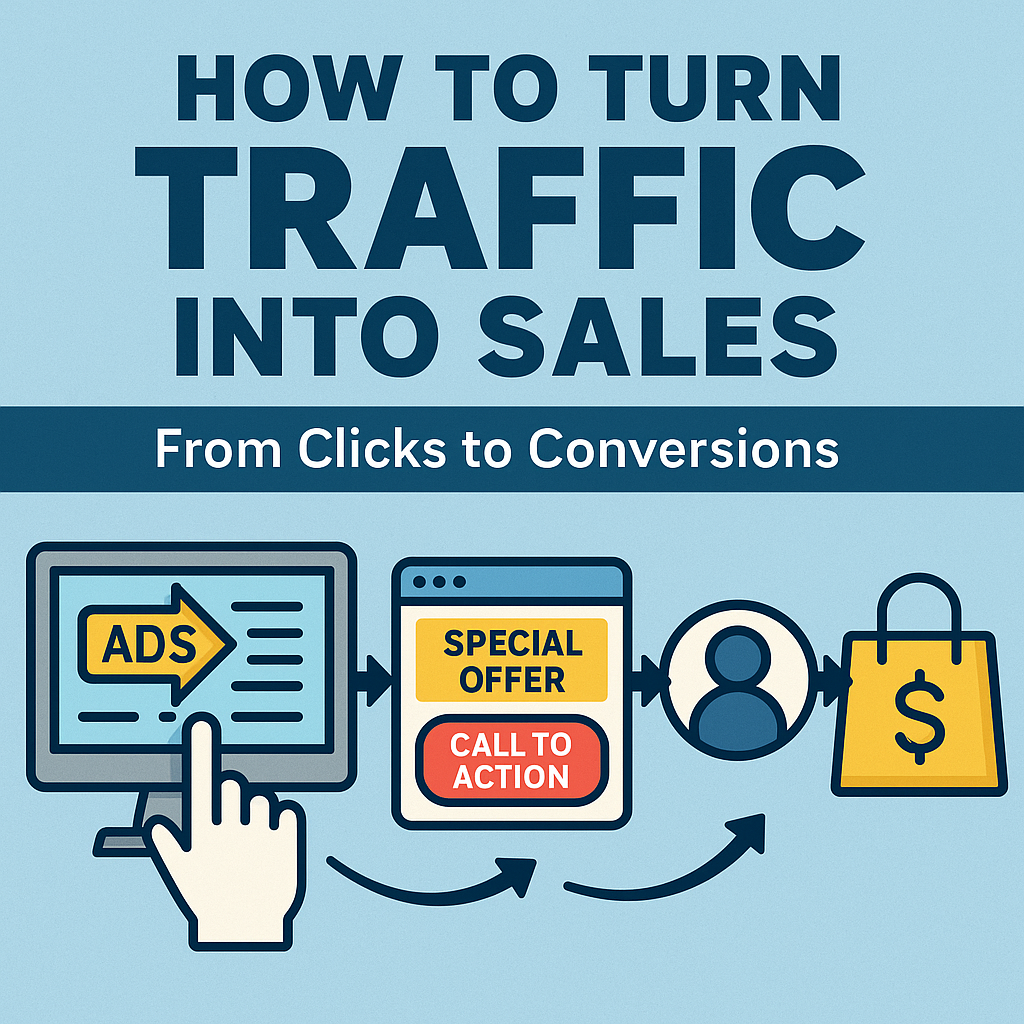Running ads and generating clicks is exciting — but clicks alone don’t pay the bills.
Many beginner traffic managers focus all their efforts on bringing people to a website, forgetting the most important part: what happens after the click.
Driving traffic is only step one. The real value lies in turning that traffic into leads, sales, or clients.
In this article, you’ll learn how to go beyond clicks and structure your campaigns and funnels to maximize conversions and generate real results.
Why Clicks Alone Aren’t Enough
Imagine running a Facebook ad that gets 500 clicks — but zero sales.
What happened?
Chances are:
- The offer wasn’t clear
- The landing page wasn’t optimized
- The targeting was off
- There was no follow-up system
Clicks without conversions mean wasted budget. Your job as a traffic manager is to ensure that every step — from ad to action — is aligned and built for performance.
Step 1: Attract the Right Audience
Conversions start before the user clicks. It begins with relevance.
Ask yourself:
- Does the ad message match the user’s intent?
- Are we targeting people who need this solution right now?
- Is the copy clear and benefit-driven?
- Are we qualifying or disqualifying the right users?
Don’t just drive traffic — drive qualified traffic.
🎯 Example: If you’re advertising a high-ticket coaching program, don’t target people interested in “free tips.” Target those already interested in investing in results.
Step 2: Use a High-Converting Landing Page
Once someone clicks, where they land will determine if they convert.
A great landing page:
- Loads quickly (especially on mobile)
- Matches the promise made in the ad
- Has a clear headline and call-to-action (CTA)
- Avoids distractions (no menus, sidebars, external links)
- Builds trust (testimonials, security badges, guarantees)
🚫 Common mistakes:
- Sending traffic to a homepage
- Overloading the page with too much text
- Using a CTA like “Submit” instead of “Get My Free Guide”
Use tools like Leadpages, Unbounce, Carrd, or WordPress + Elementor to build focused, fast, and conversion-optimized pages.
Step 3: Align the Message From Ad to Page
There must be a 1:1 connection between what the user sees in the ad and what they see on the landing page.
Ad:
“Download our FREE 7-day meal plan for healthy weight loss”
Landing Page Headline:
✅ “Get Your Free 7-Day Weight Loss Meal Plan Today”
🚫 “Welcome to Our Website About Nutrition”
Mismatch = drop-off.
Consistency builds trust — and trust boosts conversions.
Step 4: Have a Clear and Compelling Offer
Even with perfect traffic, if the offer is weak, people won’t convert.
Good offers:
- Solve a real problem
- Deliver fast, easy value
- Include bonuses, scarcity, or urgency
- Are specific (not vague or generic)
Examples of strong offers:
- “Free 15-minute website audit”
- “50% off your first month”
- “Limited-time bonus: Free consultation when you sign up today”
Step 5: Use Retargeting to Recover Lost Visitors
Most people don’t convert on their first visit.
That’s why retargeting is key to increasing total conversions.
Use pixels to track:
- Website visitors
- Add-to-cart abandoners
- Video viewers
- Form starters who didn’t finish
Then run retargeting ads with:
- Testimonials
- Bonuses
- Scarcity messages
- New hooks or creative variations
💡 You can recover 20–30% of “lost” visitors with a good remarketing strategy.
Step 6: Optimize Your Funnel
If your funnel has more than one step (e.g., ad → landing page → thank you page → email), make sure:
- Every step flows naturally
- Pages load fast
- Forms are short and simple
- CTAs are consistent
Use heatmaps (Hotjar), scroll maps, and Google Analytics 4 to see where users drop off.
Sometimes, small tweaks (like moving a form higher on the page) can boost conversions significantly.
Step 7: Track the Right Metrics
To measure true performance, go beyond clicks. Track:
- Conversion Rate (CVR): How many visitors take action
- Cost per Lead (CPL) or Cost per Sale (CPS)
- Return on Ad Spend (ROAS)
- Drop-off rate between funnel steps
- Lead quality (Are they actually buying later?)
This helps you refine campaigns and scale only what’s working.
Bonus: Use Email to Continue the Journey
If you’re collecting leads (not direct sales), email marketing helps turn cold leads into buyers.
Set up an automated email sequence:
- Welcome and value delivery
- Overcome objections
- Share testimonials or success stories
- Present the main offer again
💡 Platforms like MailerLite, ConvertKit, or ActiveCampaign are great for beginners.
Real-Life Example: Clicks to Sales in 5 Steps
Let’s say you’re running traffic for an online course:
- Ad: Offers a free mini-guide or video
- Landing Page: Simple form to access the guide
- Thank You Page: Bonus offer (discount or limited-time upsell)
- Email Sequence: Builds trust, shares stories, re-pitches
- Follow-up Ad Campaigns: Retargeting to close the sale
That’s a full traffic-to-conversion system.
Final Thoughts: Don’t Just Get Clicks — Get Customers
Getting people to click is only the beginning.
To truly succeed as a traffic manager, you need to understand the full journey — and how to guide the user toward taking action.
- Match the message
- Craft irresistible offers
- Optimize every step of the funnel
- Track and test relentlessly
When you master this, you don’t just run ads — you build systems that grow businesses.
